Organic Garlic Production
Watch this video about growing weed free garlic
1. Preparation of Land for Garlic Planting:
Garlic is generally planted in late fall and harvested in late spring. Garlic can be grown in partially sunny areas but it thrives best in full sun. Clean the selected area by removing all the previous plant and weed debris. This can be used to make compost (Fig. 1).
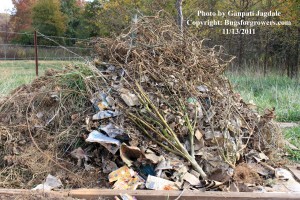
Then loosen the soil with a tiller or a shovel and level it with a rake (Fig. 2).
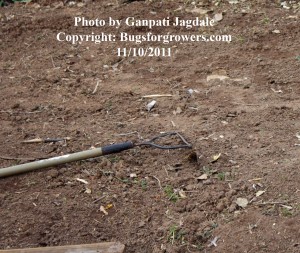
After leveling the soil, cover the whole area with old newspapers. This will block out sunlight and help prevent germination of weed seeds, which in turn will save the trouble of weeding when the garlic is growing (Fig. 3)

Secure the newspapers with 6″ wooden planks (Figs. 4 and 5) or any other available heavy material so that the papers do not fly away with the wind (Figs. 3 and 4). Using 6″ planks allows a desirable distance of 6″ to be maintained between two planting rows. While laying the planks on the newspaper, leave 3- 4 inch gap between the planks. In this way, planting rows will be formed automatically between the planks (Fig. 4).

After arranging wooden planks in each row, make holes with a metal rod or a wooden stick in the soil by ripping newspaper in a circular fashion at every 6 inches for planting garlic cloves (Fig. 5).
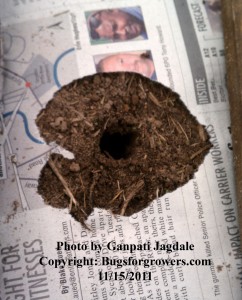
In this way a standard distance of 6 inches would be maintained between two garlic plants and between two rows. Note that the process described above (wooden planks and newspapers) is only feasible for a small garden and not for large acreage.
2. Planting Garlic:
Watch this video about planting garlic:
After the above preparations are completed, break a garlic bulb into individual cloves (Fig. 6). Select comparatively large sized cloves for planting as large sized cloves will produce large sized garlic bulbs (Fig. 7).
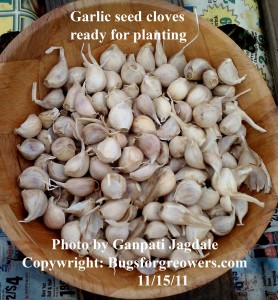
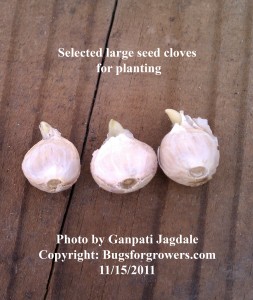
Store these cloves in a cool place until you are ready tor plant, generally the beginning of November to the end of December is an ideal time here in Georgia. In the colder parts of the country, garlic should be planted 3-4 weeks before the ground freezes. The timing of planting is important to let the garlic cloves produce a good root system before winter sets in. When optimum moisture (at field capacity) is present in the soil, plant a single selected large sized clove with pointed end up in the hole at least 1.5 to 2.0 inches deep and cover it with a thin layer of soil (Fig. 8).
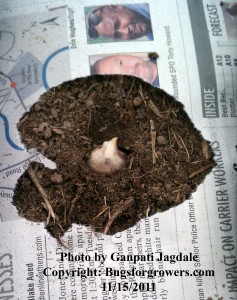
Depending on the moisture in the ground and environmental temperature, garlic cloves will sprout within 7- 10 days of planting (Fig. 9).
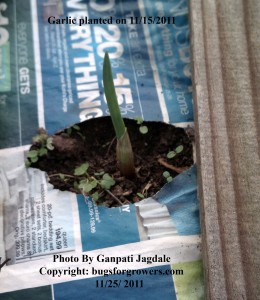
Allow garlic plants to grow until garlic plants show typical symptoms of their readiness to harvest. Fig. 10. shows growth of garlic 3 months after planting.
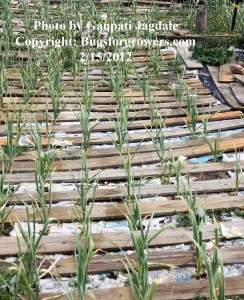
Generally garlic bulbs are ready when the lower leaves turn yellowish or brownish in color and top leaves are still greenish in color (Fig. 11). However, if you wait until all the leaves turn brown or become dry then it is too late to harvest the garlic. You will notice that all bulbs are divided (split) into separate cloves and they will not have enough leaf sheathes to wrap all the cloves together into an intact bulb, which in turn affects the storage life of garlic bulbs. Also, there is a possibility that these divided bulbs can become targets for infection by fungus or any other disease causing organisms.
3. Harvesting of Garlic:
Harvesting garlic is a very easy process but you still need to take care to avoid bruising or injuring the bulbs so that their storage life will be enhanced. Garlic bulbs sunburn easily and some varieties’ flavor will change when exposed to the sun so select a cloudy day to harvest garlic. Th ground should also be soft (i.e. a few days after moderate amount of rain) for easy uprooting. It is always advisable to loosen the soil beside the plant with a shovel or fork and then lift the plant (Fig. 11). This way the bulbs are not injured and remain intact with the stems/leaves, which are required for the process of proper curing.
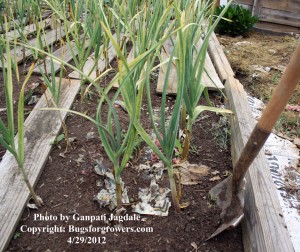
Then leave the harvested plants on the ground (if day is cloudy) for a couple of hours to dry the soil attached to the bulbs (Fig. 12).
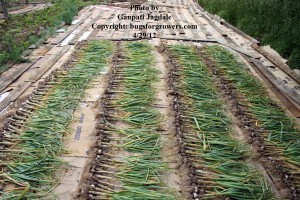
4. Curing of Garlic:
Shake the garlic plants to remove any extra dry soil from the bulbs and take them to the curing barn. For better curing, the curing barn should be a well-ventilated and warm but not hot. For curing purposes, tie the stems/leaves of four plants together (Fig. 13) and then hang them on a stick or on the rope to form a single layer for easy drying/curing (Fig. 14).
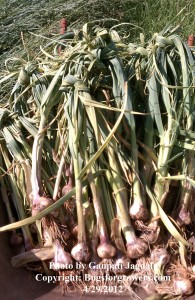
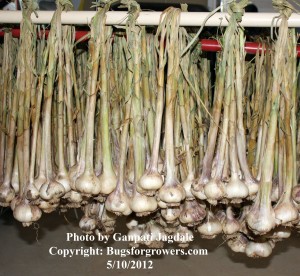
5. Storage of Garlic:
This process of curing generally takes several weeks. After curing, brush any remaining soil and loose leaf sheathes off of the bulbs, clip the roots, remove the stems and store the bulbs in mesh or paper bags (Fig. 15) in a well-ventilated and cool place.

